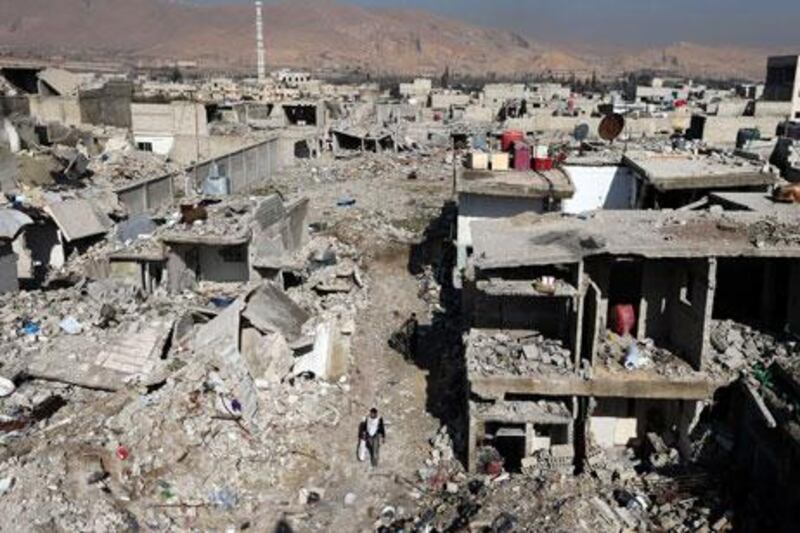DAMASCUS // There is a small, nondescript patch of wasteland on the southern edge of Damascus, right on the borderline where the outermost suburbs of the sprawling city finally end, giving way to a low range of hills.
In the winter, the piece of ground supports clumps of bright green grass which, by late spring, are burnt by the sun into rough brown scrub. Most of the time, it is just dirt, dirt that occasional rains turn into thick mud and strong winds into a fine choking dust.
Physically, this tract of land is much the same now as it has been for years, ever since the streams dried up and the fruit orchards withered distant decades ago. Yet its character has been dramatically transformed by 22 months of revolt and war, just as Syria itself has been reshaped in the tumult of revolution.
While it was no Garden of Eden - there were too many discarded plastic bags and bottles, and occasionally the corpses of poisoned stray dogs, for it to be that - it was nevertheless a part of the community, out there on the frontier of greater Damascus.
Once a place for family picnics and endless pickup football matches played by inexhaustible boys, it is now an area where the destitute forage for firewood and wild plants to eat. It is also a place where the cash-strapped municipal authority hands out limited supplies of gas canisters and bread to Syrians forced by fighting to flee their homes.
And at night, it is now a danger zone rendered off limits by a pro-government militia checkpoint on its southeastern corner.
The low hills directly to the south are no longer a charming piece of scenery visible from the kitchen windows of the last row of buildings. Instead mortars and artillery positioned up on the ridge line send their shells looping over the wasteland to explode in Daraya or Moadamyia a few kilometres to the north.
Like much of Syria-in-crisis, the plot of land is in constant, confusing flux, its nature changing from day to day and hour to hour. The rhythms that once governed this swathe of land - like the country itself - have changed utterly.
Sometimes still, the boys do play football there and children use it as a shortcut on their way to the schools that are located on either side.
Yet at other times there is gunfire, bursts of shooting that make the checkpoint militiamen reach for their weapons and duck behind a makeshift berm and which send the children scattering in fear.
When the sun is out, the wasteland still acts as a meeting place of sorts, where people relax in the fresh air. But the days of middle class residents cooking chicken over charcoal barbecues, or young men listening to music and smoking water pipes into the early hours of the morning, have long gone.
The cedar trees that line three sides of the wasteland are slowly starting to disappear, too, culled for firewood. The protection they offer from the winter storms that rush down from the Lebanese mountains to the west gets more meagre every week.
On the western edge of the ground, there is a small cement stable and deep irrigation pool. Children used to play there, camping out and making fires in the small cinder block room.
As waves of people have fled violence in the surrounding countryside and towns, however, the tin roof has been stripped off, the scavenged metal reappearing as a makeshift washroom among a group of nearby tents that have been put up by refugees.
In a similar concrete stable 300 metres away, next to a widely used communal water tap, a decomposing headless corpse was found last year, stuffed in rubbish sacks. It was days before it was moved because no one seemed to know what to do with it. The head was never found.
Abu Waleed, the local shepherd, still grazes his goats across the threadbare grass, but as more people and their belongings crowd space considered relatively safe, the competition stiffens. Another livestock owner looking for pasture took his malnourished cows there last week - marching them through a boys' football match - only to be turned away by the angry goatherd.
But it is at night that the ground's character shifts most dramatically, turning into a no-man's-land, beyond which are scattered factories and dirt roads that only the foolhardy dare pass through after dark, driving with reckless speed, swerving around roadblocks and potholes.
Those cars drive with the headlights switched off and the barrels of assault rifles point out of their open windows.
Boys dressed in the brightly coloured shirts of Barcelona and Chelsea used to play football out there on the dusty pitch until long after sunset, so absorbed in their matches they would forget to notice the blackness engulfing them.
Two years into the Syrian uprising, if the boys have been out during the day, they are called in by anxious mothers and fathers long before the sun drops behind the mountains.
Today the darkness on the edge of town is more complete than it ever was, made denser by the power cuts.
Nightfall always brings the sounds of gunfire and shelling, the packs of feral dogs howl in response. No one walks there after dark anymore.
psands@thenational.ae





